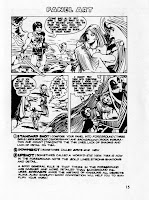
If anything could get ya to subscribe to a Charlton comic, that was it, baby!
Well, that long-forgotten, highly-treasured (finding a copy now would set you back anywhere from twenty to two hundred bucks on today's market!) little give-away was the brainchild of non other than E-Man creator Nick Cuti. Filled with gorgeous art samples by Ditko, Staton, Howard, and Sutton, along with Cuti's tips and tricks on everything from what tools to use to the wisdom of keeping a swipe-file (!) to the importance of writing your stories with the Comics Code in mind, TCBGftAWL was one handy-dandy little booklet.
What made Charlton put out such a book? Why would they share the "secrets" of making comics with anyone with a buck-and-a-quarter? As the old saying goes, "necessity is the mother of invention" (I think that was Frank Zappa...). Here's the skinny from Cuti, himself, courtesy Comic Book Artist #12 (March 2000), page 40:
"I wrote the booklet because we were getting portfolios from people at a rate of about two a day. Most of them were awful but occasionally we'd get portfolios from very talented people who just didn't know the mechanics of comic book art. So we decided to do the booklet as a quick way to help those artists. Later, we thought they might be a useful gimmick to boost our subscriptions."
And there you have it! The "Secret Origin" of TCBGftAWL! Okay, all you comicbook creators-in-waiting! Here's everything you need to know to produce your very own Groovy Age/Charlton style comics! If this post inspires you to actually sit down and create something, scan it and send it to Ol' Groove! I'll post it here for all your fellow Groove-ophiles to enjoy!
UPDATE! Sherm Cohen of Cartoon SNAP! has converted TCBGftAWL into a .pdf file you can download here! Thanks, Sherm! For your efforts above and beyond the call of duty, you now rank in the highest echelons of Groove-dom!





































Thanks for posting this! I always wondered what this book looked like. It may come off as very basic but honestly, a lot of modern comic creators could stand to give it a quick read....
ReplyDeletegroovy,
ReplyDeleteyou are the best! i've owned at least two or three copies of this in my life. i REALLY REALLY wish i still had one. this was my bible back in the day.
now i'm gonna have to print one out!!! thanks for the blast of nostalgia, this blog is THA GREATEST!
This is brilliant! I've never seen this before. What a great piece of comic book history. You rule for posting it!
ReplyDeleteGlad you dug this post, fellas! Only the best for my Groove-ophiles!
ReplyDeleteHi Groove...thanks a million for that Charlton How to Draw Comics guide...I have wanted to get a copy of that since I was a kid!
ReplyDeleteNice...thanks Sherm!
ReplyDeleteYou are showing the original 1973 printing. I own the 1976 "Revised Edition" with a black & white cover.
ReplyDeletehttp://covergallery.sinfree.net/Charlton/Comic_Book_Guide/Comic_Book_Guide.html
Defiant1
I recall getting a subscription at the time and not only never getting the art book, but only getting the first couple issues of the subscription. Charlton was not a reliable company...
ReplyDeleteThanks for poting it!
Thanks for posting this historical find. Sure there are a lot of clues to Charton's demise (spelling Ames wrong, not giving specific lettering settings, overall sloppiness). Your post, however, is an excellent pre-Marvel Guide tutorial on traditional ink-on-paper techniques which -- even in this digital era -- offers huge dividends. Thanks, thanks, thanks.
ReplyDeleteDavid Marshall
Comic Book Author/Writer and Teacher
I remember seeing this advertised WAY back in the old Super Hero Merchandise catalogs that the Kubert school illustrated.
ReplyDeleteBack then all my money went to DC and Marvel. I didn't have a lot and had to keep up with the whole superhero thing.
Charlton production values were the worst in the industry. As I've gotten older I've really grown a fondness for their stuff esp all that great Ditko.
I had long since forgotten about this great little piece. Thanks so much Groove Man for posting it !
This is an AWESOME basic guide. I get a kick out of The Comic Book Code.... very '70s. Is that still in use? If so, it must have been updated.
ReplyDelete